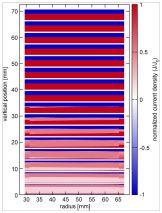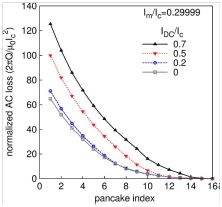AC loss modelling for HTS coils
Many superconducting applications are usually charged and discharged under a bias dc current, which may increase the ac loss. For their design, it is necessary to understand and predict the ac loss. The analysis is based on a numerical model that takes the interaction between magnetization currents in all turns into account. The studied example is a stack of 32 pancake coils with 200 turns each made of thin tape, such as ReBCO-coated conductor. We have found that the loss increases with the dc bias current. The instantaneous power loss is the largest in the initial rise of the ac current. In the following cycles, the power loss is higher in the current increase than in the decrease. The loss per cycle is the largest at the end pancakes. The presented model has a high potential to predict the ac loss in magnet-size coils, useful for their design.


Half of the pancakes of the coil are saturated with critical current density after setting the dc current corresponding to IDC = 0.5Ic (a) and loss per cycle and tape length is the highest at the end pancakes (b).
Pardo, E.: Modelling of AC loss in coils made of thin tapes under DC bias current, IEEE Trans. Applied Supercond. 24 (2014) 4700105.
Pardo, E.: Calculation of AC loss in coated conductor coils with a large number of turns, Supercond. Sci Technol. 26 (2013) 105017.
Pardo, E., Šouc, J., and Kováč, J.: AC loss in ReBCO pancake coils and stacks of them: modelling and measurement, Supercond. Sci Technol. 25 (2012) 035003.
 Contact
Contact Intranet
Intranet SK
SK

